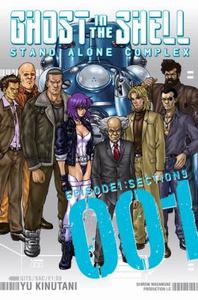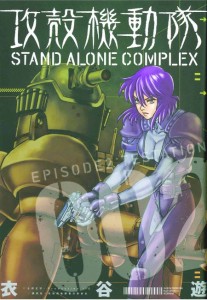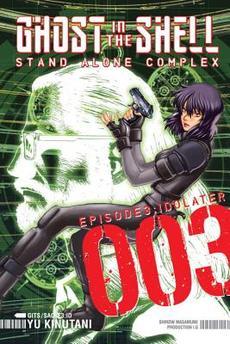SF Manga 101: Ghost in the Shell – Stand Alone Complex
Glenn Hough (gallyangel) is a nonpracticing futurist, an anime and manga otaku, and is almost obsessive about finishing several of the lists tracked on WWEnd. In this series on SF Manga Glenn will provide an overview of the medium and the place of science fiction within it.
 And in the Beginning there was the Major…
And in the Beginning there was the Major…
What Shirow started over two decades ago is still rolling along. The Ghost in the Shell manga I talked about way back at the start of this little series, is now informally known as GITS 1.0, which is followed by GITS 1.5 and GITS 2.0. Next come the Stand Alone Complex series of takubons and three original novels. There have also been three movies, two seasons of the Stand Alone Complex TV series, and numerous specials. As of this writing, the newest installment OAV, Ghost in the Shell: Arise (which concerns how the Major was recruited and Section 9 was created) is just out. The accompanying manga is also just out in the monthly anthologies and has not even been collected into a takubon yet. This just about sums up the official GITS franchise. Oh, did I mention games. Can’t forget about those and all of their accompanying books. (Imagine the shelf space it all takes up!)
This is what Kodansha says about the first manga Takubon of GITS:SAC.
Stand Alone Complex takes place in the year 2030, in the fictional Japanese city of New Port. The story follows the members of Public Security Section 9, a special-operations task-force made up of former military officers and police detectives. The manga presents individual cases that Section 9 investigates, along with an ongoing, more serious investigation into the serial killer and hacker known only as “The Laughing Man.”
 When a high-ranking government official is kidnapped, the Prime Minister must call in his top crime fighting force known as Section 9. Lead by the beautiful (and deadly) Major Kusanagi, the cybernetically enhanced squad must use all their skill to take down the kidnappers and rescue the hostages. But that’s only half of the mission; can Kusanagi and company find out who’s behind the kidnapping, and, more importantly, just what they’re after?
When a high-ranking government official is kidnapped, the Prime Minister must call in his top crime fighting force known as Section 9. Lead by the beautiful (and deadly) Major Kusanagi, the cybernetically enhanced squad must use all their skill to take down the kidnappers and rescue the hostages. But that’s only half of the mission; can Kusanagi and company find out who’s behind the kidnapping, and, more importantly, just what they’re after?
GITS:SAC, in terms of its relationship to Ghost in the Shell 1.0, 1.5, and 2.0 is that of an alternative timeline. This is Section 9 and our beloved Kusanagi doing their day-to-day job, without going down the truly transformational pathway that meeting the Puppetmaster takes them on.
GITS:SAC is essentially a novelization of the GITS:SAC anime and follows the strongest story lines of the show. As with all good SF based on preexisting video, we don’t need the source material to get it. The work stands on its own and is well worth our time and attention.
 So far, each volume of the takubon is a full and distinct story. We are presented with a representative assortment of tasks for Section 9 to deal with: kidnapping, a rampaging tank, ghost dubbing, and the assassination of a Japanese financial billionaire. From these episodes, flowers the details of the world Kusanagi and company are living in: politics, economics, technology, and the global problamatique. The pacing alone allows for a more in-depth exploration of this world. In contrast, Shirow’s original work rushes by, hitting us over the head with staggering technical concepts and their striking philosophical consequences. Shirow didn’t have the time nor, I suspect, the interest in emotional tenor for his original work. GITS:SAC has the time, makes the time.
So far, each volume of the takubon is a full and distinct story. We are presented with a representative assortment of tasks for Section 9 to deal with: kidnapping, a rampaging tank, ghost dubbing, and the assassination of a Japanese financial billionaire. From these episodes, flowers the details of the world Kusanagi and company are living in: politics, economics, technology, and the global problamatique. The pacing alone allows for a more in-depth exploration of this world. In contrast, Shirow’s original work rushes by, hitting us over the head with staggering technical concepts and their striking philosophical consequences. Shirow didn’t have the time nor, I suspect, the interest in emotional tenor for his original work. GITS:SAC has the time, makes the time.
I hope I’m not giving the impression that GITS:SAC is slow or plodding. When this manga needs to move, like in a fight sequence, it moves. Or with the investigations Section 9 are currently undertaking, they’re not bogged down in needless detail. I think there’s a very nice balance at work here so that action, detail, and emotion all have their place. I think one of the major factors in helping this along is the 20 plus year gap between the creation of the storylines. Shirow’s original was published in 1989! And it marks what I’ve called an “epochal boundary in the annals of SF.” For it’s time, GITS is out there, pushing boundaries. When we fastforward to today, those boundaries are far better known, the territory itself is better known. With just a little more time spent on world building, GITS:SAC reaps huge dividends because we’re more familiar with the concepts, technology, and attitudes of this world, since we seem to be currently living in the precursor stages already. (And that’s not even mentioning the ripples of effect GITS has had in mainstream U.S. SF or in Hollywood.)
 Now, the big question: What is a Stand Alone Complex?
Now, the big question: What is a Stand Alone Complex?
I’m sure we’re all familiar with the flash dance mob, where many seeming random people suddenly break into a choreographed dance. SAC is an opposite social effect: that many people look as if they are working in concert but in actuality they are not. This is not exactly like copycat behavior, where people are copying some initial behavior, like arson, terrorism or some other action which galvanized public attention. With SAC, there does not need to be an initial incident, a behavior to be copied. All that needs to happens is the rumor or the illusion that the trigger behavior has occurred. This facade of a causation only has to exist in the minds of the public before the effect then is copied. The result is an exponential increase in the behavior, as it’s copied and recopied, resulting in something which looks like purposeful, in concert action, where in reality, nothing of the kind exists. It’s obvious that belief is more important than fact in this situation. It’s also obvious that public opinion is a crucial factor and should not overshadow technology itself. Since the communications network permeates society, the degree of similarity of information and stimuli makes the percentage of like responses in large groups go higher and higher. This comes to us straight out of the concepts of memes, which Kusanagi and the Puppetmaster touch upon first in GITS 1.0. It also ties in with some social theory as well.
 In the end, it’s a question of reality building. Facts and actions can be interpreted by public opinion, which in turn, are manipulated by whomever (government, media, military, corporations, religions, etc…) which in turn are adjusted by facts and actions.
In the end, it’s a question of reality building. Facts and actions can be interpreted by public opinion, which in turn, are manipulated by whomever (government, media, military, corporations, religions, etc…) which in turn are adjusted by facts and actions.
If you thought GITS:SAC would just be violence, a cool female lead, cyberazation of humanity, and SF with a political bent, you get that too. There’s a bit more lurking underneath it all. We all know that any piece of data in the modern digital age can literally spring into existence with the manipulations of a bunch of ones and zeros. No corresponding connection to anything we quaintly call the real world is needed. It’s at this point where cyber criminals come on the scene. Which necessitates organizations like Section 9 and people like the Major.
Which brings us right back to where we started.
And in the Beginning there was the Major…
Ghost in the Shell: Stand Alone Complex is brought to us by our good friends at Kodansha Comics. All four volumes are in print and easily obtainable from your favorite brick-n-mortar or online bookseller.



















 Full Details
Full Details


No comments yet.
Sorry, the comment form is closed at this time.